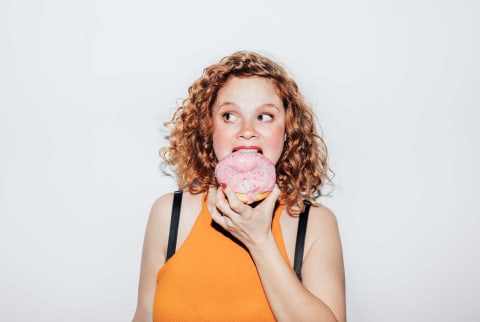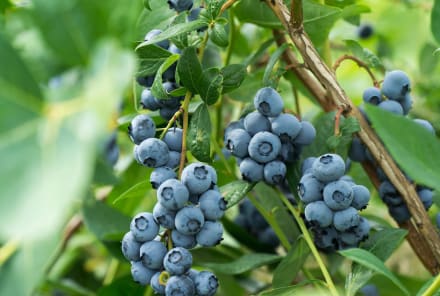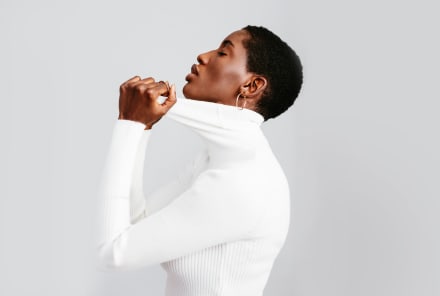Advertisement
Uh, Why Do My Sugar Cravings Go Through The Roof When I Stop Drinking?


If you have quit or attempted to change your alcohol behaviors in the past, you've probably experienced the extreme sugar cravings that come along with alcohol reduction. Many people are shocked to find that while they have cravings for alcohol when they cut back, the sugar cravings are more extreme and difficult to manage than the alcohol itself.
There are a few reasons why we are plagued by these extreme sugar cravings when we quit drinking
Alcohol triggers a release of dopamine1 in the brain, one of our "feel-good" hormones that is also released when we consume drugs, as well as sugar. We may experience lower levels of dopamine and seek out a "hit" of that feel-good hormone, which is lacking without the presence of alcohol.
But dopamine isn't the only reason we seek sugar. In his book Under the Influence, psychologist James Milam reported that more than 95% of alcoholics (or those with alcohol use disorder) have low blood sugar or a tendency toward hypoglycemia. These low blood sugar reactions cause us to crave sugar and carbs in the same way we crave alcohol. This piece of information clarified for me that regular, chronic alcohol consumption could be linked to our blood sugar levels. This is also indicated in several studies that show a correlation between blood sugar levels and alcohol craving and use2.
It's important to know that by understanding these underlying mechanisms, we can structure our food choices and meals to help fight these cravings.
In the meantime, you may be asking yourself if you should or shouldn't be indulging in these cravings. After all, part of cutting back or eliminating alcohol from your system is to improve your health, right? My perspective is that it is also OK to indulge in sweets if it helps keep you off alcohol.
We can focus first on eliminating alcohol and then worry about sugar later. If you need to pause and go scoop yourself some ice cream or grab yourself whatever sweet snack you like, it's OK! I'll wait...
Cravings for alcohol and our blood sugar
Cravings for alcohol are one of the biggest deterrents to our cutting back or eliminating it entirely. We find that cravings or triggers appear frequently and make it difficult for us to change our behaviors and make real progress. And while it's very common for us to beat ourselves up for not being strong enough to pass on the drink (aka the aforementioned willpower), this sensation is the result of physiological changes in the body.
Understanding the relationship between blood sugar and the endocrine system will have a real impact on pushing past cravings and creating a sustainable approach to reducing alcohol long term.
Picture this: You're out with friends after a long week at the office. On the way there, you told yourself that you were going to have only one drink and then head home, get into your favorite PJ's, and open a book before dozing off around 10 p.m. But once you arrived and got going, that first drink made you feel so good, and it took the edge off just enough for you to give in and have another. And another. You wake up the next morning groggy, with a splitting headache. You had hoped to have a productive morning only to find yourself on the couch until noon. You wished that you had stuck with your original plan of having only one drink but once again gave in to the glass. Does this sound familiar?
If so, you're not alone. Most people who drink alcohol can attest to the same—trying to moderate their behavior and cutting themselves off after one drink, only to be unsuccessful. This happens for a few reasons. First, once we begin to loosen up from the first drink, our inhibitions lower, and we begin to feel relaxed. This feel-good sensation leads us to believe that having another drink will allow us to continue to feel this sense of pleasure3.
Next, the alcoholic beverage will raise our blood sugar (also referred to as blood glucose)—both from the alcohol itself as well as any sugar and carbohydrates found in the beverage2. A surge in blood sugar often makes us feel energized and elated. However, shortly after, that first drink begins to metabolize through our body, and blood sugar then drops. If you've ever experienced low blood sugar, it can feel like being "hangry" and irritable and often gives us strong cravings for foods and beverages that will quickly bring blood sugar back to a normal level. This happens with regular alcohol intake in both the short term and the long term4.
And what helps raise our blood glucose? Sugar, carbs, and alcohol. This pattern sets off a roller coaster of blood sugar changes that make us want the next drink (and might also set us up to indulge in that late-night pizza, fast food, or dessert that we can't resist at midnight or later).
This is the perfect recipe for poor sleep, followed by low energy and imbalanced blood sugar the next day (hence the cravings for indulgent foods during a hangover). For those who are drinking multiple times per week, you can see how this pattern begins to take hold over your life and can make it difficult to stick to a lifestyle that focuses on healthy eating and healthy habits.
All of that said, our blood sugar can be easily managed by the food we eat and the timing of when we eat.
Foods to support blood sugar & hormone balance
These foods can be used strategically to help support blood sugar balance, hormone balance, and the stress response:
- Protein: Protein is one of the key food groups to focus on when balancing blood sugar. Protein not only helps improve satiety but also helps keep us feeling full for longer. Protein should be incorporated at each meal and snack throughout the day and come from a variety of sources, like lean meats, seafood, eggs, dairy, nuts, seeds, beans, and legumes. Plant-based eaters must be especially mindful to consume enough protein throughout the day to keep their blood sugar balanced, as vegan and vegetarian protein sources contain lower total protein content.
- Healthy fats: Healthy fats are key to the production of our sex hormones, which are derived from fats in the body, in addition to aiding in nutrient absorption and improving bowel regularity. Healthy fats are generally categorized as monounsaturated or polyunsaturated fats. These can be found in foods like avocado, olive oil, nuts, seeds, and others. When consuming animal-based sources of fat, quality is key. Wild-caught fish and grass-fed beef contain higher levels of omega-3 fats, which also support a healthy hormonal system.
- Complex carbohydrates: Not all carbohydrate sources are equal. There are two main types of carbs: simple and complex. Simple carbohydrates are easily converted to sugar in the body and generally cause a sharp increase in blood sugar followed by a drop (the type of response we're looking to avoid). Simple carbs are refined carbs like processed wheat flour, refined grains, and simple sugars found in sweets and baked goods. On the other hand, complex carbohydrates contain fiber that helps reduce their impact on blood sugar. Examples include fruits, vegetables, and whole grains like brown rice, farro, and others. Complex carbs should be the go-to choice when choosing carbs for your meals.
Excerpted from How To Eat To Change How You Drink by Brooke Scheller, DCN, CNS. Copyright © 2023 by Brooke Scheller, DCN, CNS. Reprinted with permission of Balance Publishing, an imprint of Hachette Book Group. All rights reserved.


















